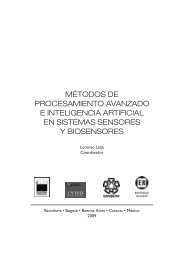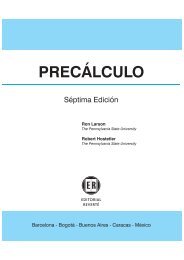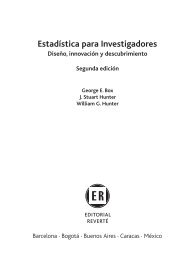Chapter 11 Gravity
Chapter 11 Gravity
Chapter 11 Gravity
You also want an ePaper? Increase the reach of your titles
YUMPU automatically turns print PDFs into web optimized ePapers that Google loves.
<strong>Gravity</strong><br />
Picture the Problem We can determine the maximum range at which an object<br />
with a given mass can be detected by substituting the equation for the<br />
gravitational field in the expression for the resolution of the meter and solving for<br />
the distance. Differentiating g(r) with respect to r, separating variables to obtain<br />
dg/g, and approximating Δr with dr will allow us to determine the vertical change<br />
in the position of the gravity meter in Earth’s gravitational field is detectable.<br />
(a) Earth’s gravitational field is<br />
given by:<br />
Express the gravitational field due to<br />
the mass m (assumed to be a point<br />
mass) of your friend and relate it to<br />
the resolution of the meter:<br />
Solving for r yields:<br />
GM<br />
g E =<br />
R<br />
g<br />
() r<br />
r = R<br />
E<br />
2<br />
E<br />
Gm<br />
= = 1.<br />
00×<br />
10<br />
2<br />
r<br />
−<strong>11</strong><br />
GM<br />
= 1.<br />
00×<br />
10<br />
R<br />
E<br />
1.<br />
00×<br />
10<br />
M<br />
Substitute numerical values and<br />
<strong>11</strong><br />
6 1.<br />
00×<br />
10<br />
evaluate r: ( ) ( 80kg)<br />
r = 6.37× 10 m<br />
24<br />
(b) Differentiate g(r) and simplify to<br />
obtain:<br />
=<br />
7.<br />
37m<br />
E<br />
<strong>11</strong><br />
m<br />
−<strong>11</strong><br />
E<br />
2<br />
E<br />
g<br />
E<br />
5.98×<br />
10<br />
kg<br />
dg − 2Gm<br />
2 ⎛ Gm ⎞ 2<br />
= = − = − g<br />
3 ⎜ 2 ⎟<br />
dr r r ⎝ r ⎠ r<br />
Separate variables to obtain: dg dr −<strong>11</strong><br />
= −2<br />
= 10<br />
g r<br />
Approximating dr with Δr, evaluate<br />
Δr with r = RE:<br />
Δr<br />
= −<br />
1<br />
2<br />
−<strong>11</strong><br />
6<br />
( 1.<br />
00×<br />
10 )( 6.<br />
37×<br />
10 m)<br />
= 31.<br />
9μm<br />
43 •• Earth’s radius is 6370 km and the moon’s radius is<br />
1738 km. The acceleration of gravity at the surface of the moon is 1.62 m/s 2 .<br />
What is the ratio of the average density of the moon to that of Earth?<br />
Picture the Problem We can use the definitions of the gravitational fields at the<br />
surfaces of Earth and the moon to express the accelerations due to gravity at these<br />
locations in terms of the average densities of Earth and the moon. Expressing the<br />
ratio of these accelerations will lead us to the ratio of the densities.<br />
229

















